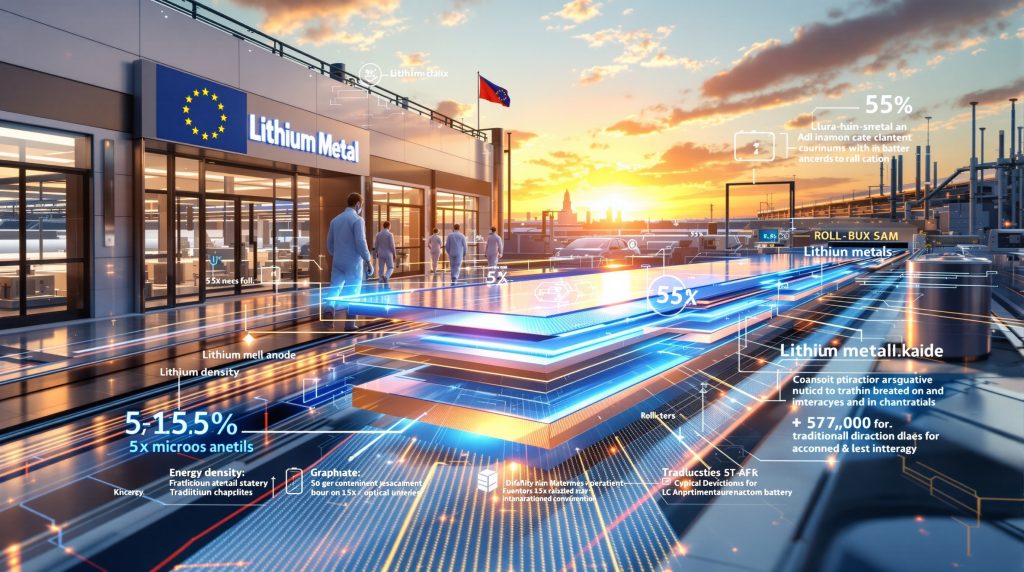European lithium metal batteries represent a revolutionary advancement in energy storage technology, offering transformative potential for electric vehicles, aviation, and renewable energy applications. Unlike conventional lithium-ion systems that rely on graphite anodes, lithium metal batteries utilize pure lithium metal as the anode material, delivering unprecedented energy density capabilities. Furthermore, recent developments in battery recycling breakthrough technologies are complementing these manufacturing advances.
The fundamental difference lies in the anode chemistry and structure. Traditional lithium-ion batteries store lithium ions within graphite layers during charging, limiting capacity to approximately 372 mAh/g. In contrast, lithium metal anodes provide a theoretical capacity of 3,860 mAh/g, representing more than a tenfold improvement in energy storage potential per unit weight.
This dramatic enhancement in energy density translates to practical advantages across multiple applications:
• Electric aviation: Extended flight ranges and reduced battery weight for aircraft electrification
• Long-range electric vehicles: Potential for 500-mile+ driving ranges with current vehicle architectures
• Grid-scale storage: Higher capacity installations requiring less physical space
• Consumer electronics: Longer device operation with smaller, lighter battery packs
However, the superior performance comes with significant manufacturing challenges. Lithium metal anodes require precise thickness control within 5-15 micrometer tolerances to prevent dendrite formation, which can cause safety hazards including thermal runaway and fire risk. The reactive nature of lithium metal also demands specialised processing environments and handling protocols.
Europe's pursuit of advanced anode production capabilities addresses critical supply chain vulnerabilities in the rapidly expanding battery market. Currently, the continent depends heavily on Asian suppliers for battery components, creating strategic risks for automotive manufacturers and energy storage developers. Establishing domestic lithium metal anode production capacity would enhance European technological sovereignty while supporting the continent's ambitious electrification targets.
How Does the STELLAR Project Address European Battery Manufacturing Gaps?
The STELLAR project, formally titled "Safe, Sustainable, and High-throughput Production of Reliable Lithium Metal Anodes for Gen 4b/4c/5 Batteries," represents a coordinated European response to next-generation battery manufacturing challenges. This ambitious initiative brings together 16 European partners under the coordination of Avesta Holding, a Belgian lithium battery developer and manufacturer.
The European Commission has allocated €7.9 million in funding for the four-year project timeline, running from June 2025 through May 31, 2029. This investment reflects the strategic importance of developing indigenous battery manufacturing capabilities within the European Union's broader Battery Alliance framework. Moreover, this initiative aligns with broader battery metals investment trends across the continent.
Project Consortium Structure:
• Lead Coordinator: Avesta Holding (Belgium) – battery development and manufacturing expertise
• Research Partners: Fraunhofer ITWM and 15 additional European institutions
• Technology Focus: Roll-to-roll lithium metal anode production
• Commercial Objective: Pilot-scale facility demonstrating industrial viability
The project addresses several critical gaps in European battery manufacturing infrastructure:
Supply Chain Localisation: Reducing dependence on non-European anode suppliers while building domestic technical expertise in advanced battery components.
Manufacturing Innovation: Developing scalable production methodologies that can transition from laboratory research to industrial implementation.
Safety Standardisation: Establishing European protocols for handling reactive lithium metal in manufacturing environments.
Technology Integration: Creating digital twin systems and process optimisation tools that can be deployed across multiple manufacturing facilities.
The STELLAR initiative aligns with European Battery Alliance objectives to establish a competitive, sustainable battery value chain from raw materials through recycling. By focusing on next-generation lithium metal anodes, the project positions European manufacturers to participate in emerging high-performance battery markets rather than competing solely in mature lithium-ion segments.
What Makes Roll-to-Roll Lithium Metal Anode Production Revolutionary?
Roll-to-roll manufacturing represents a paradigm shift from traditional batch processing methods, enabling continuous production of lithium metal anodes at industrial scale. This approach adapts proven techniques from flexible electronics and optical coating industries to the unique challenges of reactive metal deposition. Additionally, innovations in lithium industry innovations are supporting these manufacturing advances globally.
Technical Process Overview:
The production system continuously unwinds copper foil substrates from supply rolls, processes them through vacuum deposition chambers where precise lithium layers are applied, then rewinds the completed anodes onto collection rolls. This continuous methodology eliminates the handling interruptions and contamination risks associated with sheet-by-sheet processing.
Key Process Parameters:
| Specification | Target Value | Manufacturing Significance |
|---|---|---|
| Lithium Layer Thickness | 5-15 micrometers | Prevents dendrite formation while maximising capacity |
| Annual Production Capacity | 60 kilometres of foil | Industrial-scale output suitable for battery manufacturers |
| Processing Environment | Continuous vacuum chamber | Prevents lithium oxidation and contamination |
| Quality Monitoring | Real-time optical measurement | Immediate defect detection and process correction |
Substrate Preparation and Handling:
Copper foil substrates undergo careful preparation to ensure optimal lithium adhesion and uniform deposition. The continuous handling system maintains precise tension control while preventing mechanical damage to the ultra-thin copper base material. Advanced web handling technologies borrowed from printing and coating industries enable consistent foil positioning throughout the deposition process.
Vacuum Deposition Technology:
The vacuum chamber environment serves multiple critical functions. First, it prevents atmospheric contamination that would compromise lithium metal quality. Second, controlled vacuum conditions enable precise control over deposition rates and uniformity. Third, the sealed environment minimises safety risks associated with reactive lithium exposure to moisture and oxygen.
Continuous Processing Advantages:
• Higher Throughput: Elimination of batch loading/unloading cycles increases overall production rates
• Improved Consistency: Continuous process conditions reduce batch-to-batch variations
• Reduced Contamination: Minimal handling exposure maintains product purity
• Lower Labour Requirements: Automated operation reduces manual intervention needs
• Scalability Potential: Easier capacity expansion through longer chamber systems or multiple parallel lines
The revolutionary nature of this approach lies in applying continuous manufacturing principles to highly reactive materials that traditionally required careful batch handling. Success in roll-to-roll lithium metal deposition could establish European leadership in next-generation anode manufacturing technology.
How Does Fraunhofer ITWM's Optical Measurement Technology Ensure Quality?
Fraunhofer ITWM's optical measurement system represents a critical innovation enabling real-time quality control during continuous lithium metal anode production. The technology addresses fundamental challenges in monitoring coating properties under vacuum conditions while maintaining the high-speed processing required for commercial viability.
Real-Time Monitoring Capabilities:
The optical measurement system continuously monitors multiple critical parameters throughout the roll-to-roll process:
• Layer Thickness: Precise measurement within the 5-15 micrometer specification range
• Surface Texture: Detection of coating irregularities that could affect battery performance
• Electrical Conductivity: Verification of proper lithium metal properties
• Edge Quality: Assessment of cutting precision and edge integrity
• Coating Uniformity: Identification of thickness variations across foil width
According to Dr. Stefan Duran, project manager at Fraunhofer ITWM, the organisation's comprehensive measurement technology portfolio enables adaptation to the specific requirements of lithium metal anode production. This flexibility allows optimisation of measurement approaches based on processing conditions and quality specifications.
Process Optimisation Through Advanced Analytics:
The measurement system integrates sophisticated data analysis capabilities that extend beyond simple quality monitoring:
Machine Learning Integration: Algorithms analyse measurement data patterns to predict potential defects before they occur, enabling proactive process adjustments.
Digital Twin Development: Virtual process models incorporate real-time measurement data to simulate production scenarios and optimise operating parameters.
Automated Decision-Making: The system can automatically adjust deposition parameters when measurements indicate deviation from quality specifications.
Predictive Maintenance: Continuous monitoring data enables prediction of equipment maintenance needs before performance degradation affects product quality.
Technical Implementation Challenges:
Implementing optical measurement in vacuum environments presents unique technical challenges:
• Optical Access: Maintaining measurement precision through vacuum chamber windows
• High-Speed Scanning: Achieving measurement accuracy at production line speeds
• Environmental Stability: Compensating for thermal and mechanical variations in vacuum chambers
• Data Processing: Managing high-volume measurement data streams in real-time
The success of this measurement technology development could establish new standards for quality control in advanced battery manufacturing, potentially influencing production methods beyond lithium metal anodes.
What Are the Commercial Implications for European Battery Independence?
The STELLAR project's commercial success could fundamentally reshape European positioning in the global battery supply chain, transitioning the continent from a net importer of battery components to a technology leader in next-generation anode manufacturing. This development aligns with broader advances in direct lithium extraction technologies that are revolutionising resource processing.
Supply Chain Strategic Benefits:
European lithium metal anode production addresses several critical supply chain vulnerabilities currently facing the continent's battery industry:
Reduced Import Dependency: Domestic anode production decreases reliance on Asian suppliers, providing greater supply security for European automotive and energy storage manufacturers.
Shortened Supply Chains: Local production reduces transportation costs, delivery times, and carbon emissions associated with long-distance component shipping.
Enhanced Quality Control: Direct oversight of manufacturing processes enables European companies to implement specific quality standards tailored to their applications.
Currency Risk Mitigation: Domestic sourcing eliminates foreign exchange exposure in component procurement.
Market Positioning Opportunities:
Successful development of roll-to-roll lithium metal anode production creates several commercial opportunities for European companies:
• Technology Licensing: European companies could licence manufacturing processes to global battery manufacturers
• Equipment Export: Production machinery and measurement systems developed through STELLAR could become export products
• Consulting Services: Technical expertise gained during development could support similar projects worldwide
• Joint Ventures: European companies could partner with international manufacturers to establish regional production facilities
Economic Impact Projections:
While specific job creation numbers require additional economic analysis, the project's industrial implementation could generate employment across multiple skill levels:
Manufacturing Positions: Production operators, maintenance technicians, and quality control specialists for facility operations.
Engineering Roles: Process engineers, equipment specialists, and research positions supporting continuous improvement initiatives.
Support Services: Administrative, logistics, and business development functions supporting commercial operations.
The broader economic multiplier effects could extend to supplier companies providing materials, equipment, and services to the lithium metal anode industry.
Investment Attraction Potential:
Demonstration of successful lithium metal anode production could attract additional private and public investment in European battery manufacturing capabilities, creating a positive feedback loop for technological advancement and industrial development. Furthermore, securing critical raw materials supply remains essential for these manufacturing initiatives.
Which Battery Generations Will Benefit from STELLAR Technology?
The STELLAR project specifically targets next-generation battery technologies designated as Generation 4b, 4c, and 5 systems, representing significant advances beyond current lithium-ion battery capabilities.
Generation 4b/4c Solid-State Battery Integration:
Solid-state batteries combine lithium metal anodes with solid electrolytes, creating systems with enhanced safety and performance characteristics:
Enhanced Safety Profiles: Solid electrolytes eliminate flammable liquid electrolytes, reducing fire and explosion risks associated with traditional battery failures.
Temperature Stability Improvements: Solid-state systems maintain performance across wider temperature ranges, enabling applications in extreme environments.
Charging Speed Advantages: Solid electrolytes can potentially support faster lithium ion transport, reducing charging times for electric vehicles and other applications.
Mechanical Durability: Solid-state construction provides greater resistance to physical damage and vibration compared to liquid electrolyte systems.
Generation 5 Lithium-Sulfur Applications:
Lithium-sulfur battery systems represent the next major advancement in energy storage technology, offering theoretical energy density improvements that could revolutionise multiple industries:
Energy Density Potential: Lithium-sulfur systems offer theoretical energy densities significantly higher than current lithium-ion technology, though specific values require validation through peer-reviewed research.
Material Cost Advantages: Sulfur's abundance and low cost compared to cobalt and nickel could reduce overall battery system costs.
Weight Reduction Benefits: Higher energy density enables lighter battery packs for aerospace, automotive, and portable electronics applications.
Environmental Considerations: Sulfur-based systems may offer improved environmental profiles compared to rare earth-dependent battery chemistries.
Application-Specific Advantages:
Different battery generations address distinct market requirements:
| Battery Generation | Primary Applications | Key Advantages |
|---|---|---|
| Generation 4b/4c (Solid-State) | Premium electric vehicles, aerospace systems | Enhanced safety, temperature stability |
| Generation 5 (Lithium-Sulfur) | Long-range transportation, grid storage | High energy density, cost reduction potential |
Technical Readiness Timeline:
The commercial deployment of these advanced battery generations depends on resolving multiple technical challenges beyond anode production:
• Electrolyte Development: Solid electrolytes require continued optimisation for ionic conductivity and mechanical properties
• Manufacturing Scale-Up: Production processes must achieve industrial scale while maintaining quality and cost competitiveness
• System Integration: Battery management systems need adaptation for new chemistries and performance characteristics
• Regulatory Approval: Safety testing and certification processes must address new battery technologies
The STELLAR project's lithium metal anode technology provides a critical foundation enabling these next-generation battery systems to achieve their full potential.
How Does STELLAR Address Sustainability in Battery Manufacturing?
Environmental sustainability represents a core design principle throughout the STELLAR project, addressing both manufacturing process impacts and end-of-life battery considerations.
Manufacturing Process Environmental Benefits:
The vacuum deposition methodology employed in STELLAR production offers several environmental advantages over alternative manufacturing approaches:
Solvent Elimination: Vacuum processing eliminates the need for organic solvents typically required in coating processes, reducing volatile organic compound emissions and waste disposal requirements.
Energy Efficiency Optimisation: Roll-to-roll methodology reduces energy consumption per unit area compared to batch processing systems that require repeated heating and cooling cycles.
Material Waste Minimisation: Precision deposition technology reduces lithium metal waste by applying exact layer thicknesses without excess material usage.
Controlled Atmosphere Benefits: Vacuum environments prevent lithium oxidation, reducing material losses that occur in atmospheric processing methods.
Circular Economy Integration:
The project incorporates end-of-life considerations to support circular battery economy principles:
Lithium Recovery Optimisation: Pure lithium metal anodes may offer more efficient recovery pathways compared to lithium compounds embedded in graphite matrices.
Copper Foil Recycling: The copper substrate represents a valuable material stream that can be recovered and reprocessed for new anode production.
Manufacturing Scrap Management: Production scrap containing lithium metal can be collected and reprocessed, minimising waste disposal requirements.
Design for Disassembly: Battery pack designs incorporating STELLAR anodes consider disassembly procedures that facilitate component separation and material recovery.
Life Cycle Assessment Considerations:
Comprehensive sustainability evaluation requires analysis of environmental impacts across the complete battery lifecycle:
• Raw Material Extraction: Lithium mining and processing environmental impacts
• Manufacturing Energy: Production facility energy requirements and carbon footprint
• Transportation: Shipping and distribution environmental costs
• Use Phase: Battery efficiency and longevity impacts on total environmental burden
• End-of-Life: Recycling effectiveness and waste minimisation
Digital Twin Environmental Optimisation:
According to European Commission project documentation, STELLAR includes development of data-driven digital twin systems for integral process optimisation. These systems can identify opportunities for environmental impact reduction through:
Process Parameter Optimisation: Adjusting manufacturing conditions to minimise energy consumption while maintaining quality specifications.
Predictive Maintenance: Reducing equipment failures and associated material waste through predictive maintenance scheduling.
Resource Efficiency: Optimising material usage patterns to minimise waste generation and maximise production yield.
The project's sustainability approach recognises that environmental performance must be integrated with commercial viability to achieve widespread adoption of cleaner battery manufacturing technologies.
What Challenges Must STELLAR Overcome for Commercial Success?
The transition from laboratory research to commercial lithium metal anode production requires overcoming significant technical, economic, and market challenges that could determine the project's ultimate impact on European battery manufacturing.
Technical Manufacturing Hurdles:
Several critical technical challenges must be resolved for successful scale-up:
Uniform Lithium Deposition: Maintaining consistent 5-15 micrometer thickness across the full width of continuous foil presents significant engineering challenges, particularly at production speeds required for commercial viability.
Oxidation Prevention: Lithium metal's extreme reactivity with atmospheric moisture and oxygen requires sophisticated handling and storage systems that add complexity and cost to manufacturing operations.
Edge Quality Control: Continuous processing must achieve consistent edge quality without defects that could compromise battery assembly or performance.
Vacuum System Scaling: Maintaining vacuum conditions across large continuous processing chambers while achieving commercial throughput rates requires advanced vacuum technology and significant energy input.
Quality Control Integration: Real-time measurement systems must achieve sufficient speed and accuracy to enable immediate process corrections without interrupting continuous production flow.
Economic Competitiveness Barriers:
Commercial adoption depends on achieving cost competitiveness with established battery technologies:
Capital Investment Requirements: Roll-to-roll vacuum deposition facilities require substantial initial investment in specialised equipment, potentially creating barriers for smaller manufacturers.
Operating Cost Optimisation: Energy consumption for vacuum processing and facility environmental control must be minimised to achieve competitive production costs.
Yield Rate Achievement: Manufacturing yields must exceed minimum thresholds to justify the premium associated with lithium metal anode technology.
Scale Economy Development: Production volumes must reach sufficient levels to achieve economies of scale that make lithium metal anodes cost-competitive with graphite alternatives.
Market Adoption Challenges:
Successfully developed technology faces additional hurdles in market acceptance:
Performance Validation: Battery manufacturers require extensive testing and qualification procedures before adopting new anode materials in commercial products.
Supply Chain Integration: Existing battery manufacturing processes may require modification to accommodate lithium metal anodes, creating adoption barriers.
Regulatory Compliance: New battery chemistries face regulatory approval processes that can extend commercialisation timelines significantly.
Customer Education: Market education regarding lithium metal battery advantages may be required to justify premium pricing during early adoption phases.
Risk Mitigation Strategies:
The STELLAR project incorporates several approaches to address these challenges:
• Pilot Scale Demonstration: Testing at industrial-relevant scales before full commercial implementation
• Multi-Partner Collaboration: Distributing risks and expertise across 16 European partners
• Digital Twin Development: Virtual process optimisation to reduce physical testing requirements and accelerate development
• Quality System Integration: Advanced measurement and control systems to ensure consistent product quality
Success in overcoming these challenges could establish European leadership in next-generation battery manufacturing technology.
### When Will STELLAR Technology Impact the European Battery Market?
The STELLAR project timeline provides a structured pathway from current research phase through potential commercial deployment, with specific milestones determining market impact timing.
Development Phase Schedule (2025-2029):
Year 1-2 (2025-2026): Pilot Facility Development
• Construction and commissioning of roll-to-roll test facility at Avesta Holding's Belgian location
• Initial equipment installation and vacuum system optimisation
• Preliminary lithium deposition testing and process parameter development
• Optical measurement system integration and calibration
Year 2-3 (2027-2028): Process Optimisation and Scale-Up
• Achievement of target production rates and quality specifications
• Digital twin system development and validation
• Extended production trials demonstrating industrial viability
• Cost analysis and economic modelling for commercial scale-up
Year 4 (2029): Commercial Readiness Assessment
• Technology transfer preparation and licensing framework development
• Final performance validation and quality certification
• Market readiness evaluation and potential partner identification
• Scale-up investment planning and facility design optimisation
Market Integration Projections:
Post-project commercial deployment will likely follow established technology adoption patterns for advanced battery materials:
Phase 1: Premium Applications (2030-2032)
Initial market adoption will likely focus on high-value applications where superior performance justifies premium pricing:
• Luxury Electric Vehicles: Premium automotive brands seeking differentiation through extended range capabilities
• Aerospace Systems: Aviation applications requiring maximum energy density for weight-sensitive operations
• Specialised Electronics: High-performance devices where battery life provides competitive advantage
Phase 2: Mainstream Electric Vehicle Integration (2033-2035)
As production scales and costs decrease, adoption could expand to broader automotive markets:
• Mid-Market Electric Vehicles: Integration into vehicles targeting mainstream consumer adoption
• Commercial Vehicle Applications: Trucks and buses requiring extended range capabilities
• Marine Systems: Electric boats and ships benefiting from high energy density storage
Phase 3: Consumer Electronics and Grid Storage (2035+)
Long-term applications could include cost-sensitive markets as technology matures:
• Consumer Electronics: Smartphones, laptops, and portable devices with extended battery life
• Residential Energy Storage: Home battery systems with improved capacity and longevity
• Grid-Scale Storage: Utility applications requiring high energy density for space-constrained installations
Market Readiness Indicators:
Several factors will determine actual commercialisation timing:
• Technical Performance Achievement: Meeting all safety, quality, and performance specifications consistently
• Cost Competitiveness: Achieving production costs that enable market-competitive pricing
• Regulatory Approval: Obtaining necessary certifications for target applications
• Supply Chain Development: Establishing reliable suppliers for specialised materials and equipment
• Market Demand: Customer acceptance and ordering patterns for next-generation battery systems
Investment and Scaling Considerations:
Commercial success will require additional investment beyond the initial €7.9 million research phase:
Manufacturing Facility Investment: Full-scale production facilities could require tens of millions of euros in capital investment.
Supply Chain Development: Supporting infrastructure for materials, equipment, and services will need coordinated development.
Market Development: Sales, marketing, and technical support capabilities must be established to serve commercial customers.
The timing of European lithium metal anode market impact ultimately depends on successful execution of technical milestones combined with favourable market conditions for next-generation battery adoption.
STELLAR's Role in Europe's Battery Future
The STELLAR project represents a strategic investment in European technological independence within the rapidly evolving global battery industry. Through innovative roll-to-roll production methodologies and advanced quality control systems, this initiative positions Europe to compete effectively in next-generation energy storage markets while reducing dependence on external suppliers.
The project's focus on lithium metal anodes addresses fundamental limitations of current battery technologies, potentially enabling energy density improvements that could accelerate electric vehicle adoption and support renewable energy integration. Success in developing cost-effective production processes would provide European manufacturers with access to superior battery technologies while supporting the continent's broader electrification and decarbonisation objectives.
Beyond immediate technical achievements, STELLAR's emphasis on sustainability and circular economy principles aligns with European environmental priorities. The vacuum processing approach eliminates harmful solvents while precision deposition minimises material waste, establishing environmental performance standards for advanced battery manufacturing.
The four-year development timeline through 2029 will determine European competitiveness in emerging battery markets. Commercial viability will ultimately depend on achieving technical performance targets while maintaining cost competitiveness with established lithium-ion systems. Success could attract additional investment across the European battery value chain, from raw material processing through battery pack assembly and recycling.
As global demand for advanced battery systems accelerates, the STELLAR project's outcomes will influence strategic decisions throughout European industry. The technology's commercial success would validate European capabilities in next-generation manufacturing while providing a foundation for continued innovation in sustainable energy storage solutions.
Industry professionals and investors seeking deeper understanding of European battery manufacturing developments can explore additional resources through advanced anode production research initiatives and government technology development programmes.
Looking to Capitalise on Advanced Battery Technology Developments?
Discovery Alert's proprietary Discovery IQ model delivers real-time notifications on significant ASX mineral discoveries, instantly empowering subscribers to identify actionable opportunities in battery metals and critical materials ahead of the broader market. Begin your 30-day free trial today and secure your competitive advantage in the rapidly evolving energy storage sector.




